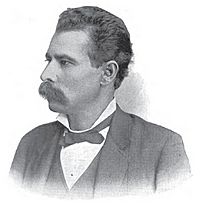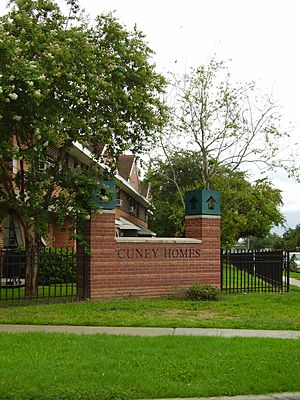Norris Wright Cuney facts for kids
Quick facts for kids
Norris Wright Cuney
|
|
|---|---|
 |
|
| Born | May 12, 1846 Hempstead, Texas, U.S.
|
| Died | March 3, 1898 (aged 51) San Antonio, Texas, U.S.
|
| Resting place | Lakeview Cemetery, Galveston, Texas |
| Other names | Wright Cuney |
| Years active | 1871–1896 |
| Known for | Leader of the Texas Republican Party, First Grand Master Prince Hall Masons of Texas http://www.mwphglotx.org |
| Political party | Republican |
| Children | Maud Cuney Hare, Lloyd Garrison Cuney |
Norris Wright Cuney (May 12, 1846 – March 3, 1898) was an important American leader. He was a politician, businessman, and a strong supporter of rights for African Americans in Texas. After the American Civil War, he became very active in Galveston politics. He served as an alderman (a city council member) and represented Texas at national meetings for the Republican Party.
In 1889, he was given a high-ranking job as the United States Collector of Customs in Galveston. This was the highest position any African American held in the Southern U.S. during the late 1800s. Cuney was part of the Union League, which helped encourage black citizens to vote Republican. By the 1890s, over 100,000 black people were voting in Texas.
Cuney also started his own business hiring stevedores (people who load and unload ships). He helped organize black workers into unions, which created more job opportunities for them on the docks. He greatly improved jobs and schooling for black people in Galveston. Eventually, he became the chairman of the Texas Republican Party and a national leader. Many people see Cuney as the most important black leader in Texas in the 19th century.
Contents
Norris Wright Cuney's Early Life and Education
Norris Wright Cuney was born on May 12, 1846, near Hempstead, Texas. He was the fourth of eight children. His mother, Adeline Stuart, was an enslaved woman of mixed African, European, and Native American heritage. His father was her owner, Colonel Philip Cuney, a wealthy white planter and politician.
Because his mother was enslaved, Norris and his siblings were also born into slavery. However, their father freed them and their mother before the Civil War. He sent his sons, including Norris, to a school for black students in Pittsburgh, Pennsylvania. Norris was freed in 1859 and began using his father's last name, Cuney. He planned to go to Oberlin College in Ohio, which welcomed students of all races, but the American Civil War stopped his plans.
During the war, Norris Cuney worked on a steamship traveling between Cincinnati and New Orleans. In New Orleans, he met important people like P. B. S. Pinchback, a mixed-race man who later became Louisiana's first black governor.
After the war, Cuney returned to Galveston, Texas. He was educated and could read and write, which gave him advantages in society. His mother and brothers also moved to Galveston. Cuney began studying law and literature on his own.
He met George T. Ruby, who worked for the Freedmen's Bureau. This government agency helped formerly enslaved people. Ruby was also part of the Union League, which worked to get black voters to join the Republican Party. Cuney became very involved with the Union League. By 1870, about one-quarter of Galveston's population was black.
Norris Wright Cuney's Career and Leadership
Cuney's career grew as Galveston became a busy port city. In 1870, he became the first sergeant-at-arms for the Texas Legislature. He also became friends with the Republican governor, Edmund J. Davis. Cuney was chosen as a state representative for the national Republican convention in 1872. He continued in this role for the next 20 years, attending every convention until 1892.
In 1871, Cuney was appointed as a school director for Galveston County, Texas. He worked to make sure that black students received a good education, even though schools were separated by race at the time.
Cuney became the head of the Union League in Galveston in 1871. In 1873, he was made secretary of the Republican State Executive Committee. That same year, he led a meeting of black leaders in Brenham, Texas.
Cuney also got important federal jobs. In 1872, he became a federal inspector of customs for the Port of Galveston. He was a popular person in the community. When business leaders wanted to improve the harbor, they asked Cuney to help.
During this time, many black organizations were forming. Cuney joined a Prince Hall Lodge of the Freemasons, a group for black Masons. He helped this group grow in Texas. In 1875, Cuney was elected the first grand master of the Most Worshipful Prince Hall Grand Lodge of Texas.
Cuney ran for mayor of Galveston in 1875 but lost. He also lost elections for the state House and Senate. However, in 1883, he was elected as an alderman (city council member) in Galveston.
In 1882, Cuney was appointed as a special inspector for customs at the port. In 1883, he started his own stevedore business, hiring 500 black dock workers. He then organized these workers into a union called the "Colored Screwmen's Benevolent Association." At the time, white unions controlled most of the jobs on the docks. Cuney encouraged black workers to take jobs even if it meant accepting lower pay. This helped more black workers get jobs on the docks and made the white unions change their rules. In 1889, Cuney was appointed as the U.S. Collector of Customs for the port. This was the highest federal job held by a black person in the South during that century.
In 1886, Cuney was elected as the Texas national committeeman for the Republican Party. He also became the Texas party chairman. This made him the most powerful African American leader in the South during the 1800s. Cuney's popularity allowed him to control the Republican Party in Texas. His achievements were even reported by The New York Times.
Cuney's leadership upset some white Republicans. They worried that if black leaders gained too much power, it would make white Southerners dislike the Republican Party. At the 1888 Republican convention, some white conservatives tried to remove important black leaders. Cuney called this effort the Lily-White Movement. Cuney kept control of the party in Texas for a while. However, most people in Texas were white and supported the Democratic Party.
In 1892, Democratic politician Grover Cleveland became U.S. President. This meant less national support for Cuney's work. In 1896, a white leader replaced him as chairman of the Texas Republican party.
Norris Wright Cuney's Family Life
On July 5, 1871, Cuney married Adelina Dowdie, a local school teacher. She was also of mixed race. They had two children, Maud and Lloyd Garrison Cuney. Lloyd was named after William Lloyd Garrison, a famous leader who fought to end slavery.
Both parents loved music. Cuney played the violin, and Adelina was a singer. They filled their home with music and art. They made sure their children got a good education and learned about writers like Shakespeare. They tried to protect their children from the racism in Galveston. Cuney's brothers and their families lived nearby, so the children often had fun gatherings with their cousins.
Maud Cuney (later known as Maud Cuney Hare) studied music in Boston. She became a talented pianist, music expert, author, and community organizer. She wrote a book about her father, published in 1913. Lloyd Cuney also received a good education and became an official in the Congregational Church.
Cuney became quite wealthy. In 1893, his net worth was about $150,000, which was a lot of money back then.
Norris Wright Cuney's Legacy
Some historians call the period in Texas between 1884 and 1896 the "Cuney era." This was a time when black people in Texas made big political gains. Cuney's efforts helped over 100,000 black people vote each year in Texas during the 1890s. His work also led to black and white workers forming unions together in Galveston in the late 1800s and early 1900s.
After Cuney died, white politicians in Southern states passed new laws to stop black people and poor white people from voting. This was to make sure white Democrats stayed in power. From 1890 to 1908, states like Texas created rules like poll taxes (a fee to vote) and white primaries (only white people could vote in the main election). This greatly reduced the number of black voters. In Texas, black voters dropped from 100,000 in the 1890s to less than 5,000 by 1906.
Cuney's example continued to inspire other black leaders. It took new federal civil rights laws in the 1960s for black Texans to fully get back their right to vote.
Memorials to Norris Wright Cuney
Several places and groups are named after Norris Wright Cuney:
- Wright Cuney Park in Galveston is where the city holds its annual Juneteenth celebration. Juneteenth celebrates the freedom of enslaved African Americans.
- The small town of Cuney, Texas, was named after Cuney Price, whose father named him after Norris Wright Cuney.
- A group of black Freemasons, the Order of the Eastern Star, Prince Hall Affiliated, renamed its Grand Chapter as the Norris Wright Cuney Grand Chapter of Texas.
- Cuney Homes is a public housing complex in Houston, named after the politician. It is near Texas Southern University and the University of Houston.
See also
- Civil rights movement (1865–1896)
- List of civil rights leaders
- Galveston, Texas
- Racism in the United States
- Texas Republican Party
- Union League


